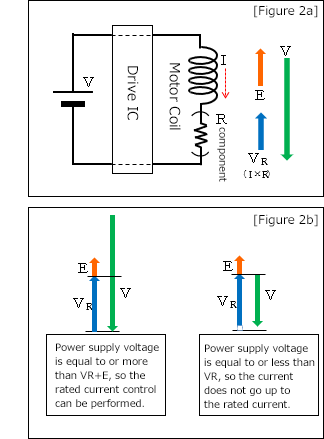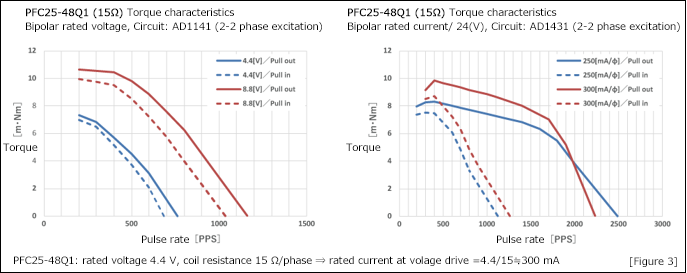1. Select a motor whose rated voltage is equal to or less than half of the rated voltage.
 As explained last time, in the constant-current motor control, you need to supply the power to the coil from power supply until the current reaches the set value. Then, the energy stored in the coil is consumed by the regeneration loop, which is repeated at regular intervals to keep the current constant (chopping control). [Figure 1]
As explained last time, in the constant-current motor control, you need to supply the power to the coil from power supply until the current reaches the set value. Then, the energy stored in the coil is consumed by the regeneration loop, which is repeated at regular intervals to keep the current constant (chopping control). [Figure 1]
Also, the relations between motor’s rated voltage, coil resistance, and rated current are roughly [rated voltage ÷ coil resistance ≒ rated current]. If the applied voltage is lower than the motor’s rated voltage, it will cause [applied voltage ÷ resistance component of coil < rated current], so the current does not go up to the rated current and chopping control will not be performed even if you set the rated current value to a drive IC.
 Furthermore, since a motor coil generates electricity when a motor rotates, the voltage applied to the motor coil is obtained by subtracting this generated voltage from the power supply voltage. Therefore, you also need to consider the power generation voltage when performing the constant-current control. [Figure 2] *1
Furthermore, since a motor coil generates electricity when a motor rotates, the voltage applied to the motor coil is obtained by subtracting this generated voltage from the power supply voltage. Therefore, you also need to consider the power generation voltage when performing the constant-current control. [Figure 2] *1
When using a constant-current drive IC, select a motor whose rated voltage is at least half or less of the power supply voltage.
*1. In the figures, the power generation voltage is stated constant, the power generation voltage, however, varies depending on the rotation speed.
2. Calculate rated current from rated voltage and coil resistance.
In constant-current drive, where the applied voltage is higher than in constant-voltage drive, the current rises faster and the influence of the generation voltage from the coil is smaller, so torque and high-speed characteristics are better than in constant-voltage drive.
With about 80% of the rated current, you can produce the same amount of torque as the constant-voltage drive depending on the applied voltage. [Fig. 3]

Thus, when selecting a stepping motor to drive with a constant-current drive IC, select a motor with a rated voltage of half or less of the applied voltage. If using a motor for constant voltage, calculate the rated current from the rated voltage and the coil resistance, and set a slightly lower current.
Also, if you only know the motor’s rated voltage or rated current, you can calculate the approximate rated current and rated voltage by measuring the actual coil resistance. Therefore, you can anticipate whether the motor can be used with constant-current drive ICs. Please note that heat generation can be large due to the actual measurement error or the motor size.
INDEX
- 1. Fundamentals of stepping motor drive IC
- 2. Specification of the signal that gives operation commands to a drive IC
- 3. Drive IC control method "Excitation mode"
- 4. Decay control
- 5. Current setting when using constant-current drive ICs
- 6. How to select a motor to drive with a constant-current drive IC
- 7. Heat generation of a motor and a driver
- 8. Acceleration and deceleration of stepping motors
- 9. Malfunctions of stepping motors